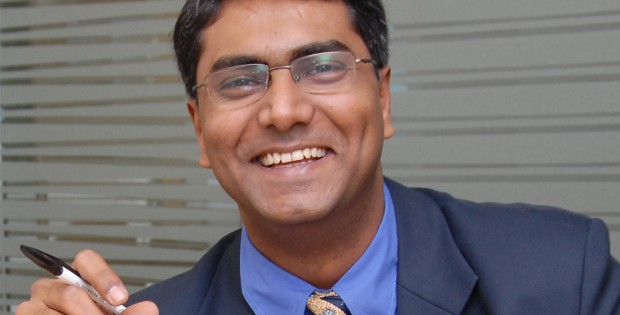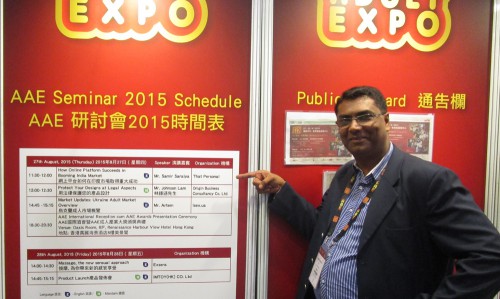
Around the world with Samir Saraiya
Given his position as CEO of Indian company Digital E-Life, Samir Saraiya gets around a lot as he visits many international trade shows and generally takes a close look at the various markets for adult products. Now, he shares his observations with EAN, in a highly interesting interview about trends, the current status of the international erotic market, and the opportunities and dangers that lie ahead.
Samir, you are jetting around the world a lot, visiting trade shows for erotic products. Which global trends and developments have been the most prominent in recent month?
Samir Saraiya: One of the most interesting developments that I see is that product innovation and differentiation is fairly limited. Lack of large scale investment dollars in this industry, coupled with quick replication of products, has led to a situation where innovative brands are getting less time to reap the benefits of their innovation. Additionally, traditional Chinese OEM and ODM manufacturers are now trying to build their own brands while, on the flip side, leading distributors are also building their own brands via private label manufacturers, leading to a situation of increased competition.
On the positive side, I believe the e-commerce revolution has led to a substantial growth of the business, this category being a natural fit for e-commerce. Additionally, the industry is slowly moving away from the ‘adult’ or ‘erotic’ positioning to more of a ‘sexual health and wellness’ kind. It is also moving towards a standard FMCG business with more distribution and retail channels like super markets, pharmacies, vending machines, and convenience stores stocking and selling these products.
Consumers are becoming more savvy than they used to be, as the presentation of product content in various forms like ratings, reviews, and videos has increased by leaps and bounds which has led to greater awareness about sex-toys and their usage. Consumers have evolved and are much more knowledgeable about the sex toy industry than before, which is a great sign of the industry moving towards maturity.
Is the Western world – Europe, the USA, and some others – still some sort of avant-garde when it comes to sex toys?
I believe that the avant-garde or renaissance of sex toys is yet to come. While the US and the European countries are the pioneers in terms of innovation and making new headwinds in this industry, the significant emergence of new age products is yet to come. Except for a few products like the We-Vibe, Hot Octopuss, OhMiBod, Womanizer etc. there is not too much going on in terms of groundbreaking, innovative products.However, there is a lot of potential with the internet and mobile revolution in terms of building technology into the products, and I believe that this will happen fairly soon.There is a need for sizeable investments in research and development. Unfortunately, this industry is not as glamorous as others, hence the investor community and the start-up community have limited participation which I believe will change in future.

Is the role of China in the erotic market changing from assembling and manufacturing toys towards a developer of new products?
Across industries, a lot of manufacturing is moving to China. In our industry, there are pure play Chinese product developers and manufactures as well as hybrid concepts like Western companies where design and development happens in the West while manufacturing is done in China. Additionally, there are companies like Wingpow that have offices in the West and do private label manufacturing in China for their Western clients. The Chinese have a great capability of quickly replicating successful products and hence the lines of new product development are getting blurred.
Culturally, unlike the West, Asian markets are generally mobile-only markets. In the West, consumers have a different device for different purposes like computer, mobile, iPod, camera, etc., while most people in Asia rely only on their cellphones for a multitude of purposes. I believe China will lead innovations connecting mobile with toys, and a good example is the company Magic Motions which claims to have developed the world’s first ‘wearable smart vibrator’ and the first ‘smart mini vibrator’ which is app-controlled and has motion sensors. A lot of Chinese OEMs and ODMs manufacturers are also moving towards building their brands for the global market and a good example is the company Odeco. In the near future, China could well be involved in the purchase of global brands across the world. TOPCO Sales, for instance, is primarily Chinese-owned already.
In case there are global trends and developments, are there also global brands? Would Fifty Shades be an example for this?
Yes, there are, but not so many examples to cite. Fifty Shades of Grey, LELO, Penthouse, and We-Vibe are some of the few brands in this industry that are known across the world. The reason is that very few brands are spending massively on brand building which is understandable because of the unavailability of capital in the industry.
LELO is a trendsetter in terms of changing the perception of sex toys with fabulous design and hence, have created an unbelievable following and brand value. Then there are other legacy brands like Hustler and Penthouse that are extremely well-known because of their association with this industry for a long period of time. Lovehoney with their brand licensing initiatives like Fifty Shades of Grey and Motörhead seems to have a lot of merit in terms of creating brands in this industry.

Compared to other markets, do the brands of the erotic market get relatively little recognition? What are, in your opinion, the reasons for this – and will it change in the future?
There is an underlying taboo associated with this industry and hence, there are restrictions in terms of brand building. There is also a lot of pushback from publishers and media owners to promote brands in this space. Even Google and Facebook have restrictions in terms of advertising. Unlike the alcohol and tobacco industry, there is limited capital available to brands for pure brand building.
Additionally, brands and distributors alike need to break the ‘adult-ness’ of these products and start moving more towards sexual health, wellness, and hygiene. Breaking the ‘adult-ness’ requires creativity, and we should leverage humour, consumer interest, and excitement about the category and sex in general. I still don’t think this has been optimised yet and there’s lots of room for improvement here. Also, what brands need to do is sell aspirations and fantasies more than the product itself.
You are active in India, which is itself a booming market. In which other countries do you see the most potential for growth of the erotic industry?
India has a lot of potential, but still nascent in terms of market size. I believe there’s a huge opportunity waiting to be tapped in the Middle East and Africa. Personally, I have been getting a lot of enquiries for partnerships and joint ventures from this region.
Distributors should evaluate the Middle East countries and the African continent as part of their growth plans. The product portfolio will differ across different customer segments and different geographies due to social and political factors. The latent potential already exists, with ‘grey markets’ already present in these regions.
Where do you see the biggest risks for the international love toy market right now?
As I mentioned before, products are getting more and more commoditised. With a proliferation of brands and little differentiation, the industry could get overcrowded and it would be difficult for some organisations to sustain in terms of margins and other costs.
Additionally, the industry has the potential to grow significantly by investing in educating consumers about the different products and their benefits. There should be outreach programmes to the medical fraternity which should in turn be prescribing products for different consumers. On the distribution side, the products need better availability at standard retail outlets.
There is debate about whether or not the erotic market is crisis-proof. How much do crises like the one that hit Europe some years ago affect this industry?
I believe the erotic market is here to stay and is less affected than other industries by a global crisis. In tough times, the luxury segment could go through challenges owing to an economic crisis. However, most of the other segments are already maturing towards FMCG, consumer durables and hygiene products. In most geographies, these products have become ingrained into the daily lives of people, and economic downturns will have a limited impact across the low and mid-price range of products. In terms of fads, there would be some fads which may come and go like BDSM.

In Western Europe, there is a lot of talk about a rising acceptance in regards of love toys. Is this something you can also see on other continents?
Yes, Western Europe has been a pioneer of this industry from the days of Beate Uhse-Rotermund, who started the first sex shop in the world, to the current market scenario. Adult toys have seen a rising acceptance in other geographies too, especially the US, Canada, and Australia where there is greater acceptance at the government level. The Asian markets through China, Japan, and South Korea will also follow suit. This trend will then slowly percolate into other geographies which traditionally have been late adopters for this industry.
Will the erotic market stay a niche-market, or will it expand into other markets or get absorbed by them respectively?
I believe that large FMCG companies will eventually recognise the humongous opportunity and potential of this category and start acquiring brands once social acceptance has increased to a certain extent. Church & Dwight (Trojan) has already entered this business and Reckitt Benckiser (Durex) is now expanding into various categories. I believe companies like Victoria’s Secret have a natural brand fit with the lingerie and cosmetic side of the industry and that it is only a matter of time before they jump in. Large companies from the FMCG, pharmaceutical, and cosmetics Industries like Unilever, P&G, and J&J that have deeper pockets and larger investment potential might want to acquire brands or companies that really innovate and create world-class products. Alternatively, once this industry gets the attention of the investor community and receives growth capital, the companies that get funding will evolve rapidly and become very stable financially.




